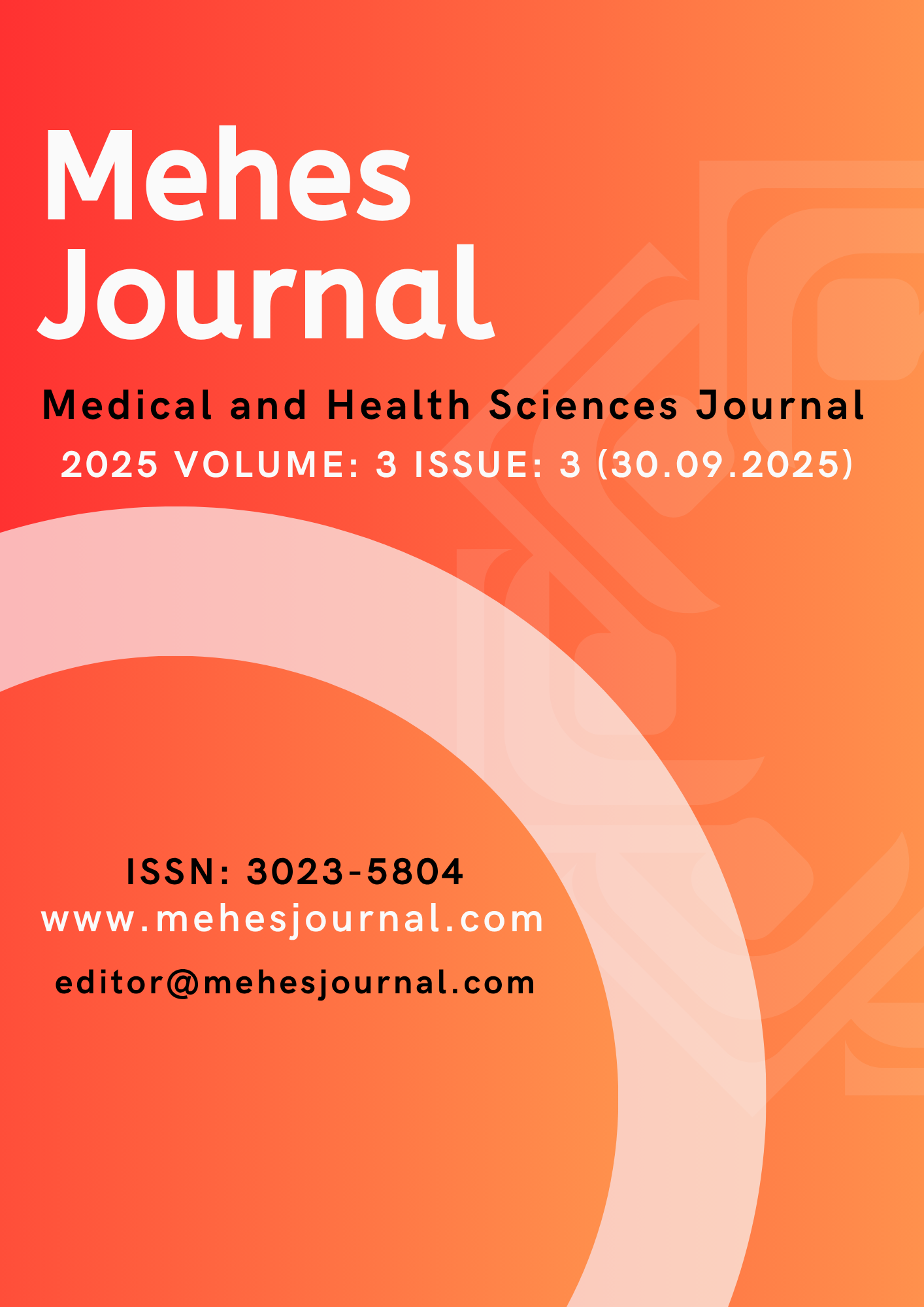Rutaceae (Sedefotugiller) Ailesine Ait Bazı Haplophyllum Türlerinin Sitotoksik Etkileri Üzerine Bir Çalışma: H. Gilesii, H. Tuberculatum, H. Myrtifolium, H. Megalanthum, H. Buxbaumii, H. Acutifolium ve H. Vulcanicum
DOI:
https://doi.org/10.5281/zenodo.17251664Anahtar Kelimeler:
Fitokimyasal bileşikler, Haplophyllum türleri, Kanser hücre hatları, Seçici antikanser etki, SitotoksisiteÖzet
Amaç: Rutaceae familyasına ait Haplophyllum cinsinin (H. gilesii, H. tuberculatum, H. myrtifolium, H. megalanthum, H. buxbaumii, H. acutifolium, H. vulcanicum) fitokimyasal çeşitliliğini ve kanser hücre hatları üzerindeki potansiyel sitotoksik/antiproliferatif etkilerini mevcut literatür ışığında özetlemek ve araştırma boşluklarını belirlemek.
Materyal ve Metot: Bu derleme çalışmasında gili tür adları ve “Haplophyllum”, “phytochemistry”, “coumarin/alkaloid/lignan/flavonoid”, “cytotoxicity”, “antiproliferative”, “apoptosis”, “IC50” anahtar kelimeleri kullanılarak uluslararası veri tabanlarında (ör. PubMed, Scopus, Web of Science) yapılandırılmış arama yapılmış; özgün araştırma, izolasyon/kimyasal karakterizasyon ve in vitro biyolojik aktivite çalışmalarına odaklanılmıştır.
Bulgular: Haplophyllum türlerinin kumarinler, alkaloitler, lignanlar ve flavonoidlerce zengin olduğu; bu sınıfların MTT, WST-1 ve brine shrimp gibi testlerde antiproliferatif ve apoptotik yanıtlarla ilişkili bulunduğu görülmüştür. Özellikle H. acutifolium ve H. buxbaumii seçici sitotoksisite açısından öne çıkarken, H. megalanthum’dan izole edilen bazı bileşiklerin düşük IC₅₀ değerleri yüksek antikanser potansiyeli işaret etmektedir. Etki profilleri, türlerin fitokimyasal çeşitliliğiyle uyumlu bir biçimde değişkenlik göstermektedir.
Tartışma ve Sonuç: Literatür, Haplophyllum türlerinin farmasötik araştırmalar için güçlü adaylar sunduğunu göstermektedir. Seçici etki ve düşük IC₅₀ değerleri ilaç keşfi açısından umut vericidir. Bununla birlikte, standardize ekstraksiyon/deney tasarımları, mekanistik doğrulamalar (hedef/pro-apoptotik yolaklar) ve in vivo/ADME-toksisite verileri sınırlıdır. Gelecek çalışmalar, biyolojik çeşitliliğin korunmasını gözeterek sürdürülebilir örneklemeyle, saf bileşik düzeyinde hedef tayini ve yapı-etki ilişkisi analizlerine odaklanmalıdır
Referanslar
Mitra JR, Eira BN, Bhawmick AK, Remon MKI, Enan ME, Muhit MA, et al. Phytochemical and pharmacological aspects of genus haplophyllum (Rutaceae): A review. International journal of health sciences.6(S9):4454-85.
Ulubelen A, Öztürk M. Alkaloids, coumarins and lignans from Haplophyllum species. Rec Nat Prod. 2008;2(3):54-69.
CC T. Taxonomic revision of the genus Haplophyllum (Rutaceae). Hooker’s icones plantarum vol 40, parts 1, Bentham-Moxon Trustees Royal Botanical Gardens, Kew. 1986.
Colombo P, Gunnarsson K, Iatropoulos M, Brughera M. Toxicological testing of cytotoxic drugs. International journal of oncology. 2001;19(5):1021-8.
Bácskay I, Nemes D, Fenyvesi F, Váradi J, Vasvári G, Fehér P, et al. Role of cytotoxicity experiments in pharmaceutical development. Cytotoxicity. 2018;8:131-46.
Razzakova D, Bessonova I, Yunusov SY. Alkaloids of Haplophyllum acutifolium. Chemistry of Natural Compounds. 1973;9:199-202.
Saglam H, Gozler T, Kivcak B, Demirci B, Baser K. Volatile compounds from Haplophyllum myrtifolium. Chemistry of Natural Compounds. 2001;37:442-4.
Mohammadhosseini M, Nekoei M, Mashayekhi HA, Aboli J. Chemical composition of the essential oil from flowers, leaves and stems of Haplophyllum perforatum by using head space solid phase microextraction. Journal of Essential Oil Bearing Plants. 2012;15(4):506-15.
Yari M, Masoudi S, Rustaiyan A. Essential oil of Haplophyllum tuberculatum (Forssk.) A. Juss. grown wild in Iran. Journal of Essential Oil Research. 2000;12(1):69-70.
Ünver-Somer N, Kaya Gİ, Sarikaya B, Önür MA, Özdemir C, Demirci B, et al. Composition of the essential oil of endemic Haplophyllum megalanthum Bornm. from Turkey. Records of Natural Products. 2012;6(1):80.
Nesmelova E, Razakova D, Akhmedzhanova V, Bessonova I. Diphyllin from Haplophyllum alberti-regelii, H. bucharicum, and H. perforatum. Chemistry of Natural Compounds. 1983;19(5):608-.
Hanahan D, Weinberg RA. Hallmarks of cancer: the next generation. cell. 2011;144(5):646-74.
Kola I, Landis J. Can the pharmaceutical industry reduce attrition rates? Nature reviews Drug discovery. 2004;3(8):711-6.
Sabry OMM, El Sayed AM, Alshalmani SK. GC/MS analysis and potential cytotoxic activity of Haplophyllum tuberculatum essential oils against lung and liver cancer cells. Pharmacognosy Journal. 2016;8(1).
Asili J, Fard MR, Ahi A, Emami SA. Chemical composition of the essential oil from aerial parts of Haplophyllum acutifolium (DC.) G. Don from Iran. Journal of Essential Oil Bearing Plants. 2011;14(2):201-7.
Gözler B, Rentsch D, Gözler T, Ünver N, Hesse M. Lignans, alkaloids and coumarins from Haplophyllum vulcanicum. Phytochemistry. 1996;42(3):695-9.
Batirov EK, Batsuren D, Malikov V. Components of Haplophyllum dauricum. Chemistry of Natural Compounds. 1984;20(2):226-7.
Yuldashev M. Flavonoids of Haplophyllum foliosum and H. pedicellatum. Chemistry of natural compounds. 2001;37:288-9.
Batirov EK, Yuldashev M, Khushbatkova Z, Syrov V, Malikov V. Flavonoids of Haplophyllum perforatum. Structure and hypoazotemic activity of haploside C. Chemistry of Natural Compounds. 1987;23:54-7.
Biniyaz T, Habibi Z, Masoudi S, Rustaiyan A. Composition of the essential oils of Haplophyllum furfuraceum Bge. ex Boiss. and Haplophyllum virgatum Spach. from Iran. Journal of Essential Oil Research. 2007;19(1):49-51.
Zengin G, Sarikurkcu C, Aktumsek A, Ceylan R, Ceylan O. A comprehensive study on phytochemical characterization of Haplophyllum myrtifolium Boiss. endemic to Turkey and its inhibitory potential against key enzymes involved in Alzheimer, skin diseases and type II diabetes. Industrial Crops and Products. 2014;53:244-51.
Javidnia K, Miri R, Soltani M, Varamini P. Volatile constituents of two species of Haplophyllum A. Juss. from Iran [H. lissonotum C. Town. and H. buxbaumii (Poir.) G. Don. subsp. mesopotamicum (Boiss.) C. Town.]. Journal of Essential Oil Research. 2009;21(1):48-51.
Esmaeili S, Hamzeloo-Moghadam M, Ghaffari S, Mosaddegh M. Cytotoxic activity screening of some medicinal plants from south of Iran. Research Journal of Pharmacognosy. 2014;1(4):19-25.
Alam J, Ali S. Contribution to the red list of the plants of Pakistan. image. 2025;42.
Kausar R, Shah AH, Jabeen T, Alam J, Ali N, Majid A, et al. Ex-situ conservation of Haplophyllum gilesii: a critically endangered and narrow endemic species of the Karakoram range. Pak J Bot. 2019;51(1):225-33.
Ashfaq S, Hussain M, Bibi N, Alam J, Junaid M, Rehman S. Antimicrobial and cytotoxic potential of Haplophyllum gilesii (Hemsl.) CC from Northern Pakistan. Pakistan Journal of Agricultural Research. 2019;33(1):146-53.
POWO. Plants of the World Online. Haplophyllum Gilesii: Royal Botanic Gardens, Kew; 2025 [Available from: https://powo.science.kew.org/taxon/urn:lsid:ipni.org:names:773868-1.
Al-Burtamani SKS, Fatope MO, Marwah RG, Onifade AK, Al-Saidi SH. Chemical composition, antibacterial and antifungal activities of the essential oil of Haplophyllum tuberculatum from Oman. Journal of ethnopharmacology. 2005;96(1-2):107-12.
Hamdi A, Bero J, Beaufay C, Flamini G, Marzouk Z, Vander Heyden Y, et al. In vitro antileishmanial and cytotoxicity activities of essential oils from Haplophyllum tuberculatum A. Juss leaves, stems and aerial parts. BMC Complementary and Alternative Medicine. 2018;18:1-10.
Ulukuş D. Türkiye Haplophyllum A. Juss. ve Ruta L. cinslerinin (Rutaceae) taksonomik, morfolojik, anatomik ve moleküler revizyonu. 2015.
Akyol Y, Alçıtepe E, Özdemir C. The morphological, anatomical and palynological properties of endemic Haplophyllum megalanthum Bornm.(Rutaceae). Pakistan Journal of Botany. 2012;44(3):1121-6.
Demir S, Petersen MJ, Kjaerulff L, Unver-Somer N, Staerk D. Cytotoxicity of endemic Haplophyllum megalanthum Bornm. and its newly isolated alkaloids and lignans. Biochemical Systematics and Ecology. 2024;117:104901.
Kazımoğlu H, Kaplan HM. Apoptotic Effect of Haplophyllum Buxbaumii Extract on Prostate Cancer. 2020.
Akçiçek D. Haplophyllum buxbaumii bitkisinin kolon kanseri hücreleri üzerindeki antikanser etkisinin incelenmesi/Investigation of the antianmal effects of haplophyllum buxbaumii plant on colon cancer cells 2019.
Staerk D, Kesting JR, Sairafianpour M, Witt M, Asili J, Emami SA, et al. Accelerated dereplication of crude extracts using HPLC–PDA–MS–SPE–NMR: Quinolinone alkaloids of Haplophyllum acutifolium. Phytochemistry. 2009;70(8):1055-61.
Varamini P, Doroudchi M, Mohagheghzadeh A, Soltani M, Ghaderi A. Cytotoxic evaluation of four haplophyllum. species with various tumor cell lines. Pharmaceutical Biology. 2007;45(4):299-302.
Ulukuş D, Tugay O, Celep F. Morphology, anatomy and palynology of Turkish endemic species Haplophyllum myrtifolium, H. vulcanicum & H. megalanthum (Rutaceae) and their systematics implications. Phytotaxa. 2016;247(3):197-209.
Karahisar E, Tugay O, Orhan IE, Sezer Senol Deniz F, Vlad Luca S, Skalicka‐Wozniak K, et al. Metabolite Profiling by Hyphenated Liquid Chromatographic Mass Spectrometric Technique (HPLC‐DAD‐ESI‐Q‐TOF‐MS/MS) and Neurobiological Potential of Haplophyllum sahinii and H. vulcanicum Extracts. Chemistry & Biodiversity. 2019;16(9):e1900333.
İndir
Yayınlanmış
Nasıl Atıf Yapılır
Sayı
Bölüm
Lisans
Telif Hakkı (c) 2025 MEHES JOURNAL

Bu çalışma Creative Commons Attribution 4.0 International License ile lisanslanmıştır.










